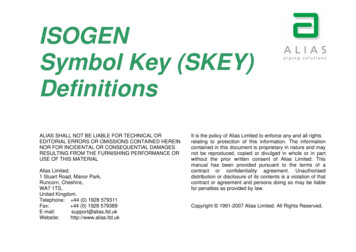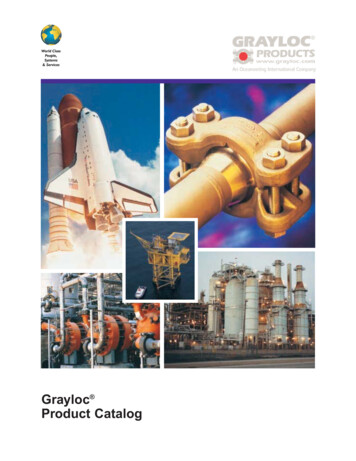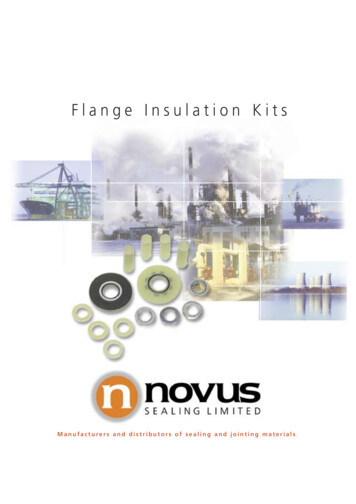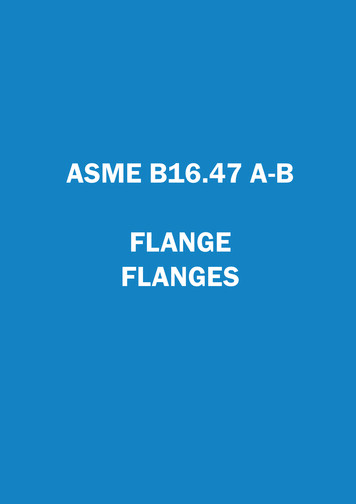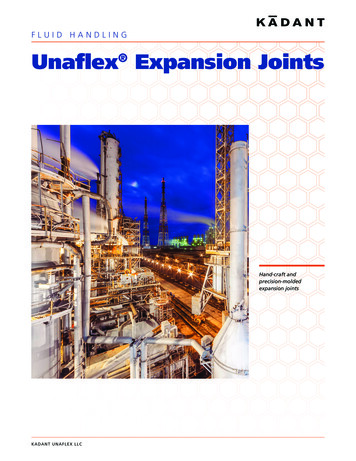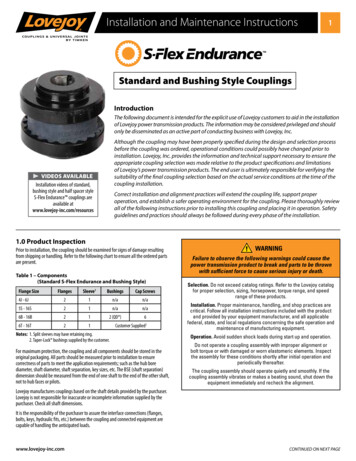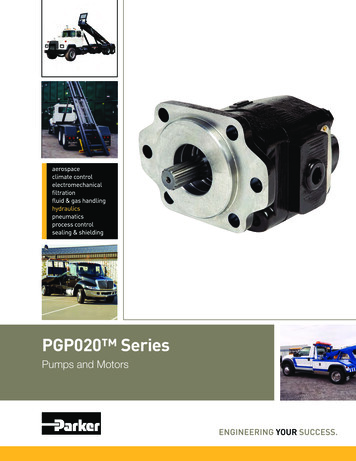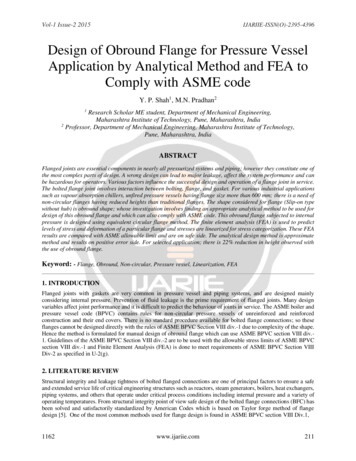
Transcription
Vol-1 Issue-2 2015IJARIIE-ISSN(O)-2395-4396Design of Obround Flange for Pressure VesselApplication by Analytical Method and FEA toComply with ASME codeY. P. Shah1, M.N. Pradhan21Research Scholar ME student, Department of Mechanical Engineering,Maharashtra Institute of Technology, Pune, Maharashtra, India2Professor, Department of Mechanical Engineering, Maharashtra Institute of Technology,Pune, Maharashtra, IndiaABSTRACTFlanged joints are essential components in nearly all pressurized systems and piping; however they constitute one ofthe most complex parts of design. A wrong design can lead to major leakage, affect the system performance and canbe hazardous for operators. Various factors influence the successful design and operation of a flange joint in service.The bolted flange joint involves interaction between bolting, flange, and gasket. For various industrial applicationssuch as vapour absorption chillers, unfired pressure vessels having flange size more than 600 mm; there is a need ofnon-circular flanges having reduced heights than traditional flanges. The shape considered for flange (Slip-on typewithout hub) is obround shape; whose investigation involves finding an appropriate analytical method to be used fordesign of this obround flange and which can also comply with ASME code. This obround flange subjected to internalpressure is designed using equivalent circular flange method. The finite element analysis (FEA) is used to predictlevels of stress and deformation of a particular flange and stresses are linearized for stress categorization. These FEAresults are compared with ASME allowable limit and are on safe side. The analytical design method is approximatemethod and results on positive error side. For selected application; there is 22% reduction in height observed withthe use of obround flange.Keyword: - Flange, Obround, Non-circular, Pressure vessel, Linearization, FEA1. INTRODUCTIONFlanged joints with gaskets are very common in pressure vessel and piping systems, and are designed mainlyconsidering internal pressure. Prevention of fluid leakage is the prime requirement of flanged joints. Many designvariables affect joint performance and it is difficult to predict the behaviour of joints in service. The ASME boiler andpressure vessel code (BPVC) contains rules for non-circular pressure vessels of unreinforced and reinforcedconstruction and their end covers. There is no standard procedure available for bolted flange connections; so theseflanges cannot be designed directly with the rules of ASME BPVC Section VIII div.-1 due to complexity of the shape.Hence the method is formulated for manual design of obround flange which can use ASME BPVC section VIII div.1. Guidelines of the ASME BPVC Section VIII div.-2 are to be used with the allowable stress limits of ASME BPVCsection VIII div.-1 and Finite Element Analysis (FEA) is done to meet requirements of ASME BPVC Section VIIIDiv-2 as specified in U-2(g).2. LITERATURE REVIEWStructural integrity and leakage tightness of bolted flanged connections are one of principal factors to ensure a safeand extended service life of critical engineering structures such as reactors, steam generators, boilers, heat exchangers,piping systems, and others that operate under critical process conditions including internal pressure and a variety ofoperating temperatures. From structural integrity point of view safe design of the bolted flange connections (BFC) hasbeen solved and satisfactorily standardized by American Codes which is based on Taylor forge method of flangedesign [5]. One of the most common methods used for flange design is found in ASME BPVC section VIII Div.1,1162www.ijariie.com211
Vol-1 Issue-2 NCLATURENominal diameter of bolts (mm)n: Total number of boltsOutside diameter of flange (mm)N: Gasket width (mm)Area of cross-section (mm2)P: Design pressure (MPa)Effective gasket seating width (mm)P: Wetted perimeter (mm)Inside diameter of flange (mm)R: Radial distance from bolt circle to point of intersection ofBasic gasket seating width (mm)hub and back of flange (mm)Bolt circle diameter (mm)Sa: Allowable bolt stress at gasket seating temperatureClearance between OD of shell and ID of flange (mm)(atmospheric temperature) (MPa)Bolt hole diameter (mm)Sb: Allowable bolt stress at operating temperature (MPa)Hydraulic diameter (mm)Sfa: Allowable stress for flange material at gasket seatingEquivalent mean gasket diameter assumed for designtemperature (atmospheric temperature) (MPa)purpose (mm)Sfb: Allowable stress for flange material at operatingMaximum inside diameter of obround shell (mm)temperature (MPa)maximum mean gasket diameter for non-circular flange (mm)SH: Calculated longitudinal stress in hub (MPa)minimum mean gasket diameter for non-circular flange (mm)SR: Calculated radial stress in flange (MPa)Minimum inside diameter of obround shell (mm)ST: Calculated tangential stress in flange (MPa)Radial distance from bolt circle to outside diameter ofSTS: Minimum tensile strength (MPa)flange (mm)SY: Minimum yield strength (MPa)Diameter at location of gasket load reaction (mm)T: Design temperature ( C)Radial distance from bolt circle to circle on which H D acts(mm)t: Flange thickness (mm)Hydrostatic end force on area inside flange (N)tg: Thickness of gasket (mm)Radial distance from gasket load reaction to bolt circle (mm)tn: Nominal thickness of the shell, pipe or nozzle to which theGasket load Wm1 - H for operating condition (N)flange is attached (mm)Radial distance from bolt circle to circle on which H T acts(mm)W: Design bolt load for the gasket seating condition (N)Difference between total hydrostatic end force and thew: Width of the straight portion of obround flange (mm)hydrostatic end force on area inside flange H-HD (N)y: Gasket / joint contact surface unit seating stress (MPa)Flange rigidityz: Factor for conversion of obround shape to circular shapeGasket factorAppendix 2, rules for bolted flange connections with ring type gaskets. Australian Standard AS1210 also follows thisapproach. These methods is adapted from of the Taylor-Forge method developed by Waters, Wesstrom, Rossheimand Williams of the Taylor-Forge company in Chicago in the 1930's and subsequently formed the basis of the ASMEcode for flanged joint design[5]. The assumptions made by this method are now generally regarded as simplistic. Thismethod gave rise to the ‘m’ and ‘y’ gasket factors in ASME section VIII as well as other codes. The calculation isbased on the axial forces balance between the bolt load, the resulting axial force due to the end thrust effect of theinternal pressure and the reaction on the gasket.Adolf E. Blach [1] in one of his work describes the two design methods for bolted flanged connection of non-circularcross-section of obround and rectangular type. One method is applicable to unreinforced “almost square" rectangularshapes, using an "equivalent circular flange", and standard flange design methods. The other is based on adecomposition of frame and flange bending stresses and may also be used for rib-reinforced pressure vessel flanges.Calculations, experimental values and finite element results were obtained for flange with ring gaskets (gasket fullyinside the flange bolt line) and full face gaskets. Comparing numerical values with experimental data, he proved thatthe method of equivalent circular flanges is suitable for obround and rectangular pressure vessel flanges within certainlimits. The results are on the safe side and become increasingly conservative as the length to width ratio increases.Muhsen Al-Sannaa and Abdulmalik Alghamdi [3] studied the results obtained using Finite Element Analysis (FEA)of large diameter welded neck steel flanges under different loading conditions. They give the stress analysis of flangedjoint made up of the flange and the gasket for large diameter steel flanges. They showed that clamping pressure is adeterminate factor for the sealing condition and that clamping pressure needs to be carefully selected to get propersealing of the flange-gasket assembly. Increasing the clamping pressure will result in better contact pressure but at thecost of higher flange stress. Gasket has to be made of soft material with low modulus of elasticity to ensure bettersealing of the assembly. Axial end load may results in gasket leakage if the clamping pressure is not sufficient.M. Murali Krishna, M.S. Shunmugam and N. Siva Prasad [4] worked on the finite element analysis of bolted flangejoint considering non-linearity of the gasket material under various loading and operating conditions. Gasketsbehaviour is complex due to nonlinear material properties combined with permanent deformation. They found that1162www.ijariie.com212
Vol-1 Issue-2 2015IJARIIE-ISSN(O)-2395-4396variation of contact stresses due to the rotation of the flange and the material properties of the gasket play importantroles in achieving a leak proof joint. Flange rotation causes variable compression across the gasket from the innerradius to the outer radius. Due to the variation in compression, the contact stresses also vary along the radius.This paper aims to find the appropriate analytical method to be used for the obround flange which can comply withASME code. The obround flange is designed using equivalent circular flange method. The finite element analysis(FEA) is used to predict levels of stress and deflection of a particular flanged joint and stresses are linearized. TheseFEA results are compared with ASME allowable limit and are on safe side. The analytical design method isapproximate method which results on positive error side.3. FLANGE DESIGNThe obround flange designed here is for the particular application in generator shell of vapour absorption chiller unit.The chiller unit is mainly used in industries and hotels for food storage or air-conditioning purpose. Mostly the fitmentof this unit is in parking area or basement where the height is restricted. So to reduce the machine height; one of theoption is to reduce the height of the generator shell and its flange with the use of non-circular shape.3.1 Forces Acting on FlangeThe forces acting on flange joint subjected to internal pressure with ring type gasket i.e. gasket is wholly within thecircle enclosed by a bolt hole and no point of contact beyond this circle [7],[8] are as shown in figure 1. The variousforces acting on flange can be represented on cross-sectional view in the required directional sense [7], [11] as shownin figure 2Fig -2: Forces represented on flange (Slip-on flangewithout hub)The initial bolt load generated upon tightening is transferred to the gasket via the flanges. This initial seating stresscompresses the gasket and tightens it within itself. The hydrostatic force generated by the system pressure, tends to‘unload’ and reduce the stress on the gasket. The stress remaining on the gasket is considered to be the ‘operating’ or‘residual’ stress. It should be seen that on a raised face assembly as shown in figure 1, there will be some deflectionof the flanges themselves (‘flange rotation’). This is a function of the load applied, the flange material and the geometryof the flanges. Thus, the operational stress towards the outside edge of the gasket tends to be greater than on the insideedge.Fig -1: forces acting in a bolted flange joint assemblyThe calculations use four loads bolt loads, gasket load, face pressure load and hydrostatic end force represented infigure 2 and two conditions seating and operating [11]. Load HD is created by the pressure on the pipe attached to theflange. During operation, Pressure is applied to the exposed edge of the gasket and gasket tries to expand but is heldin place by the flange faces. The flange faces push back and gives rise to uniformly varying pressure along gasketwidth whose average value is represented by load HT. Load HG is the force required to seat the gasket into the flangegasket face which is based on gasket physical properties.3.2 Methods for Non-Standard Flange DesignAs per the literature survey, the different methods which can be used for non-standard flange design either obroundor rectangular are:1162www.ijariie.com213
Vol-1 Issue-2 2015IJARIIE-ISSN(O)-2395-4396As per Swedish standard for pipingEquivalent circular flange methodFrame bending methodHydraulic diameter methodThese methods either convert the non-circular shape into circular shape and then we can design that circular flange orconsiders the change in shape into various formulae in design process for designing flange to be safe.1)2)3)4)1) As per Swedish standard for piping [15]:In the Swedish piping code for flange joint, the design procedure of rectangular, oval and obround flange isgiven by converting these shapes into equivalent circular shapes. This method uses the factor k4 multiplied withthe maximum mean gasket diameter Dm1 to get equivalent mean gasket diameter D’mD′m k 4 Dm1. (a)2) Equivalent circular flange method [1], [10], [11]:The method for design of non-circular pressure vessel flange is developed by Adolf E. Blach [1]. It covers thedesign of obround and rectangular shaped flanges which comply with the ASME BPVC codes. It has given twomethods of designing flange as per the shell construction. The first method is for flange mounted onunreinforced pressure vessels. This method uses the part of the procedure used in the ASME code section VIIIdiv 1 article UG-34 for the design of non-circular flat covers. In the code, a factor z is defined which relates aflat cover of obround/rectangular shape to a circular one. The factor z is given byz 3.4 2.4DSDL. (b)But factor z should not be larger than 2.5 and length to width ratio should be less than 2 is the requirement.The square root of this factor is used as a multiplier of the small side of the obround/rectangular flange toobtain an equivalent circular shape.B DS z.(c)Any obround or rectangular flange which satisfies the above criteria can then simply be designed or analysedas an equivalent circular flange, and all flange design code rules as per appendix 2 of the ASME BPVC sectionVIII division 1 are applicable without modification.3) Frame bending method [1]:The other method given by Adolf Blach is frame bending approach for non-circular pressure vessel flanges.This method is applicable to the flanges with obround or rectangular shapes mounted on reinforced vessels.The method uses a combination of frame analysis for the ability of the flange to retain its shape, and bendingof an infinitely long flanged section in a perpendicular plane with respect to the frame.In this case, the flange must also act as a stiffener for the vessel side plates, in addition to providing a tight sealbetween components. Thus, such flanges have to resist frame bending stresses, stresses which occur when aframe is subjected to internal pressure. These stresses cause deflections in a plane perpendicular to the vesselaxis. In addition, flanges also have to resist flange bending stresses in planes parallel to the axis of the vessel,stresses which occur when a flange is bolted-up about the gasket, or when internal pressure effects tend to openup the bolted connection.4) Hydraulic diameter method:This method uses the conversion of non-standard shape into circular shape using the logic of hydraulic diameter.Hydraulic diameter is the commonly used term when handling flow in non-circular tubes and channels. Usingthis term one can calculate many things in the same way as for a round tube. This is given by4𝐴𝐷 B 𝑃 . (d)This gives the equivalent inside diameter of flange which can be used in design calculations as per ASMEBPVC section VIII appendix 2.3.3 Input Parameters for DesignThe generator on which this obround flange is going to be mounted contains hot water on tube side and weak solutionof Li-Br on shell side. The working parameters needed for design of flange are as given in table I.1162www.ijariie.com214
Vol-1 Issue-2 2015IJARIIE-ISSN(O)-2395-4396Table -1: Input Parameters for Flange DesignParameterDesign PressureDesign temperatureCorrosion allowanceVessel or nozzle wall thicknessMinimum inside diameter of shellMaximum inside diameter of shellClearance between OD of shell and ID of flangeFlange thickness 0UnitMPa CmmmmmmmmmmmmThe existing circular flange outer diameter is 873.76mm which is needed to be replaced for height reduction. Thebolting is selected as in [7] and its dimensions are taken from [17] which is given in table below. Similarly for thegiven operating parameters, gasket is selected and which has following parameters required in design as specified intable III.Table -2: Bolting Specifications [17]Table -3: Gasket Specifications [11]Selected Bolt ParametersParameterLabelSelected BoltingBolt diameteraBolt hole diameterdRadial distance from bolt circle to point ofRintersection of hub and back of flangeRadial distance from bolt circle to outsideEof flangeRoot area of selected boltTotal bolts being mmmSelected Gasket ParametersSelected GasketSpitman AF 154ParameterLabel Value UnitGasket factorm1Gasket contact surfacey1.4MPaunit seating stressGasket widthN20mmGasket thicknesstg5mm3.4 Material of constructionThe material required for standard component is selected as per the operating temperature to which it is subjected andthe form of the material. The working temperature range for generator is from 150 C to 200 C i.e. 302 F to 392 F.1) Flange and bolt material:The material for flange is selected as per guidelines given in ref. [6]. The material used for the flange is SA516 Gr70 which is in the plate form and for bolts; it is SA-193-B7. Material properties are as shown in table 4.The maximum allowable stress value is the maximum unit stress permitted in a given material used in a vesselconstructed. The criteria for maximum allowable tensile stress values permitted for different materials are givenin mandatory appendix 1 & 2 of ASME BPVC Section II, Part D. As per it, the allowable stress value forselected flange material is 138 MPa and for selected bolting material is 172 MPa.Table -4: Mechanical Properties of Flange and Bolt Material [13]ParameterSelected MaterialNominal CompositionProduct FormSize / ThicknessUNS No.Tensile StrengthYield StrengthMax. TemperaturelimitDensityModulus of Elasticity1162ValueSA-516 Gr70SA-193-B7Carbon SteelCarbon steel1Cr-1/2MoPlateBolting 64K02700G41400485860260725UnitmmMPaMPa538538 C77501857750185kg/m3GPawww.ijariie.comTable -5: Properties of Spitman AF 154 GasketParameterMax operating pressureMax. Short term servicetemperatureMax. Continuous servicetemperatureMax. Operation temp.for steamDensityTensile strengthCompressibilityRecoveryWater absorptionValue150UnitBar450 C250 C290 C1800157-11% 50% 5%Kg/m3MPa215
Vol-1 Issue-2 2015IJARIIE-ISSN(O)-2395-43962) Gasket Material:Material used for gasket compressed non-asbestos fiber reinforced type (CNAF). We have considered SpitmanAF 154 (Champion seals Pvt. Ltd.) as it has superior performance compressed jointing sheet incorporating ablend of special heat resisting aramid fibres with a high quality nitrile elastomer binder. Properties of gasketare as given in table 5.3.5 Selection of Appropriate Design MethodThe selection of the appropriate method to design the obround flange will affect the flange thickness considerably.One of the key requirements of the work is that the design should comply with the ASME code.We are having 4 methods for the approximate design calculation of obround flange and each method gives differentstress values. This graph is plotted with 65 mm flange thickness, M30 (28) bolting and 20 mm gasket width. We plotthe stresses in gasket seating and operating condition of flange as shown in chart 1.It is clear from the chart that stresses generating inequivalent circular flange method are maximum of all.So if we design the flange as per equivalent circularflange method, we will design it for maximum stresscondition and it will be safe for other methods. Theother advantage of using this method is; this methoduses the ASME code for flange design with slightmodification so it will comply with ASME codes aswell. So the most appropriate method for designing ofobround flange is equivalent circular flange method.Chart -1: Trend of the stress vs. various methods3.6 Design by Formula (Analytical Method)The manual design of the obround flange is done with the equivalent circular flange method as its give the safestdesign. The manual design of slip-on type flange considers only tangential stress ST in flange which is the combinationof membrane bending stresses. The hub stress SH is considered zero as slip-on flange has nearly hub-less design andradial stress SR is consider to be entirely carried away by shell so they are ignored.With the use of the given basic dimensions we found the factor z to be 1.9567 which is below the limit of 2.5. Thenwith the help of equation (b), the inner diameter of equivalent circular shape of flange is calculated as 751.181mm. Itis just the virtual dimension of circular flange required for finding the approximate stresses in the actual obroundflange. This dimension along with the required specifications of bolting, gasket and their materials is used to find thestress occurring in flange with the help of procedure given in appendix 2 of ASME BPVC section VIII division 1. Theflange thickness appropriate for the given loading condition and dimension is found to be 70mm. The max stressgenerating in this flange is 127.93 MPa in operating condition and 118.8 MPa in gasket seating condition. The heightof the designed flange is 680.68mm. The flange dimensions also satisfies the rigidity criteria with J 0.987 which isbelow allowable limit of 1. Cover flange is also design based on the UG-34 given in [11] and the minimum thicknessrequired for flange is 45mm.4. FINITE ELEMENT ANALYSISThe modelling of generator flange for chiller is carried out in SolidWork, Release 2015 (Student Edition) and analysison its Cosmos solver. Flanges, nozzle opening on shells are important for illustration, process and inspection. Theywill not only weaken the strength of shell but also generates boundary stress on the joint of vessel flange, leading tosevere stress concentration. So the joint is most vulnerable part to failure. It’s of great importance to study the influenceof various parameters on stress distribution of the Flange. Due to different loadings applied to flange, a local stressstate of the flange connection characterized by high stress concentrations occurs in the intersection region. Thesignificant stress concentration almost always occurs in the vicinity of the flange-to-shell junction due to the inherentstructural discontinuity that is formed by the intersection.1162www.ijariie.com216
Vol-1 Issue-2 2015IJARIIE-ISSN(O)-2395-43964.1 Design by Analysis (DBA) Approach [12]Traditionally, to determine the acceptability of the design, formulas and charts based on analytical solutions andempirical data have been used. This is today called as Design by Formula (DBF) which is described by ASME VIIIDivision 1. In the 1960’s an alternative to DBF was established known as Design by Analysis (DBA). It served as acomplement for the design cases which were not covered by DBF, and was based on a method where stresses areclassified into different categories. Formulas are not always applicable and therefore design by analysis serves as acomplement within both the ASME code as allowed by U-2(g).ASME BPVC section VIII division 2 Part 5 [12] states the design by analysis requirements and includes severalmethods for evaluating the design against four different failure modes. Methods are described for evaluating againstplastic collapse, local failure, buckling, and cyclical load. The “Stress classification” method, which this work islimited to, is included in the analysis for plastic collapse and thus, this is the only failure mode that will be considered.For the elastic stress analysis method a linear elastic model is used. This means that the stress in the material is assumedto be linearly proportional to the strain. The “Stress categorization” or “elastic stress analysis-method” is used sinceit is a relatively straightforward way to obtain a result.4.2 Analysis1) Basic Assumptions:In order to simplify the analysis of the flanged joint, a number of assumptions were made. These basicassumptions are: Gasket material was assumed to have linear properties with the non-linear behaviour of the gasket sectionignored. All materials for the model of slip-on flange, shell, bolts, gasket and blind flange, are assumed isotropic. Analysis will be linear static analysis. Temperature effects will not be considered (already considered while selecting material). Bolt loads will be averaged over the area where the bolt head are located in the circular ring.2) Boundary conditions and Loads:The fix support is applied to the tubesheet which is going to be attached to evaporator shell and back side ofthe generator shell to restrain it in all direction as shown in figure 3. The pressure of 1.054 MPa is applied atthe inside of the obround shell. Then the gasket load reaction (HG) of 1449.81 N & difference between totalhydrostatic end force and hydrostatic end force acting inside the shell (HT) of 1091.67 N is applied at distanceof 26.4 mm and 32.45 mm respectively from bolt circle position in inward direction on flange face. The loadimparted on the flanged joint by the twenty eight bolts is calculated using the bolt load calculation during flangedesign. That bolt load calculated is applied on the effective bolt contact area near the every bolt holes. The totalvalue of bolt force 538272.530N is divided by number of bolts and then applied. The model is fine meshed withthe solid elements. Mesh used is the standard mesh using parabolic tetrahedral solid elements defined by fourcorner nodes, six mid-side nodes, and six edges. For the optimum selection of the mesh size and plotting of theresults, the stress convergence is established and the percentage variation must be kept under 5%.Fig -3: Boundary conditions and loading1162Fig -4: von Mises stress plot of obround flange (a)www.ijariie.com217
Vol-1 Issue-2 2015IJARIIE-ISSN(O)-2395-4396Fig -5: von Mises stress plot of obround flange (b)Fig -6: Deformation plot of obround flange3) Results:The von Mises stress plots of flange analysis are given in figure 4 and figure 5. The maximum stress generatedis 181.615 MPa. This stress value is higher than the allowable stress but below the yield strength of material.The stresses are localized at the shell and tubesheet junction and also near the bolt holes at straight to circulartransition of flange; so these need to be linearized to compare with allowable limit. The stress in the otherregions is within allowable limit.The deformation plot of obround flange subjected to given loading conditions is as shown in figure 6. Themaximum deformation obtained is 0.901 mm which is in the straight portion of shell. Maximum deformationoccurring in flange is within the range of 0.600 mm to 0.715 mm. The deformation allowed is 5 mm; so thedesign is safe for deformation & also deformation is negligible as compared to overall size of the flange. It isoccurring because of the non-symmetric shape of the shell. The shell straight portion tries to adopt more stableshape at these locations subjected to internal pressure and hence the deformation is occurring maximum there.5. LINEARIZATIONIn the finite element method, when continuum elements are used in an analysis, the total stress distribution is obtainedi.e. von Mises stress. The ASME code does not use principal stress or von Mises stress as comparable. These valuescannot be directly compared with the analytical values of stresses as calculations give the membrane and bendingstress. Therefore, to find membrane and bending stresses, the total stress distribution shall be linearized on a stresscomponent basis and used to calculate the equivalent stresses.Linearization is a decomposition of the stress distribution we see in FEA of pressure vessels. It decomposes a basicallyparabolic distribution into a uniform value (membrane stress), a linearly changing value (bending stress), and possiblyan extra component (peak stress) [14].By doing this, we can use finite element distribution and pick one or more stressclassification lines to decompose the stresses such that we can apply the code. A Stress Classification Line or SCL isa straight line running through thickness of a vessel. It is perpendicular to both the inside and outside surfaces. Theguidelines of linearization of stress results as per annexure 5-A given in [12] are used for stress classification.The maximum stress concentration zones can be identified Table -6: Allowable Stress Values for Localized Stressfrom the stress plot of the obround flange as given inQuantity (MPa)Allowable stress Valuefigures 4 & 5. The stress concentration is at transition ofMembrane StressSa138flange from straight portion to curve portion, flangeMembrane Stress Bending1.5*Sa207thickness near bolt hole and also at the intersection of shelland tubesheet. Allowable stress values as per category[14] are as given below in table VIII.5.1 Stress Linearization / Stress Classification1) At flange thickness: Firstly we perform the linearization at the flange thickness near the bolt hole in flangeStress concentration line is marked on the section of
Hence the method is formulated for manual design of obround flange which can use ASME BPVC section VIII div.-1. Guidelines of the ASME BPVC Section VIII div.-2 are to be used with the allowable stress limits of ASME BPVC section VIII div.-1 and Finite Element Analysis (FEA) is done to mee
